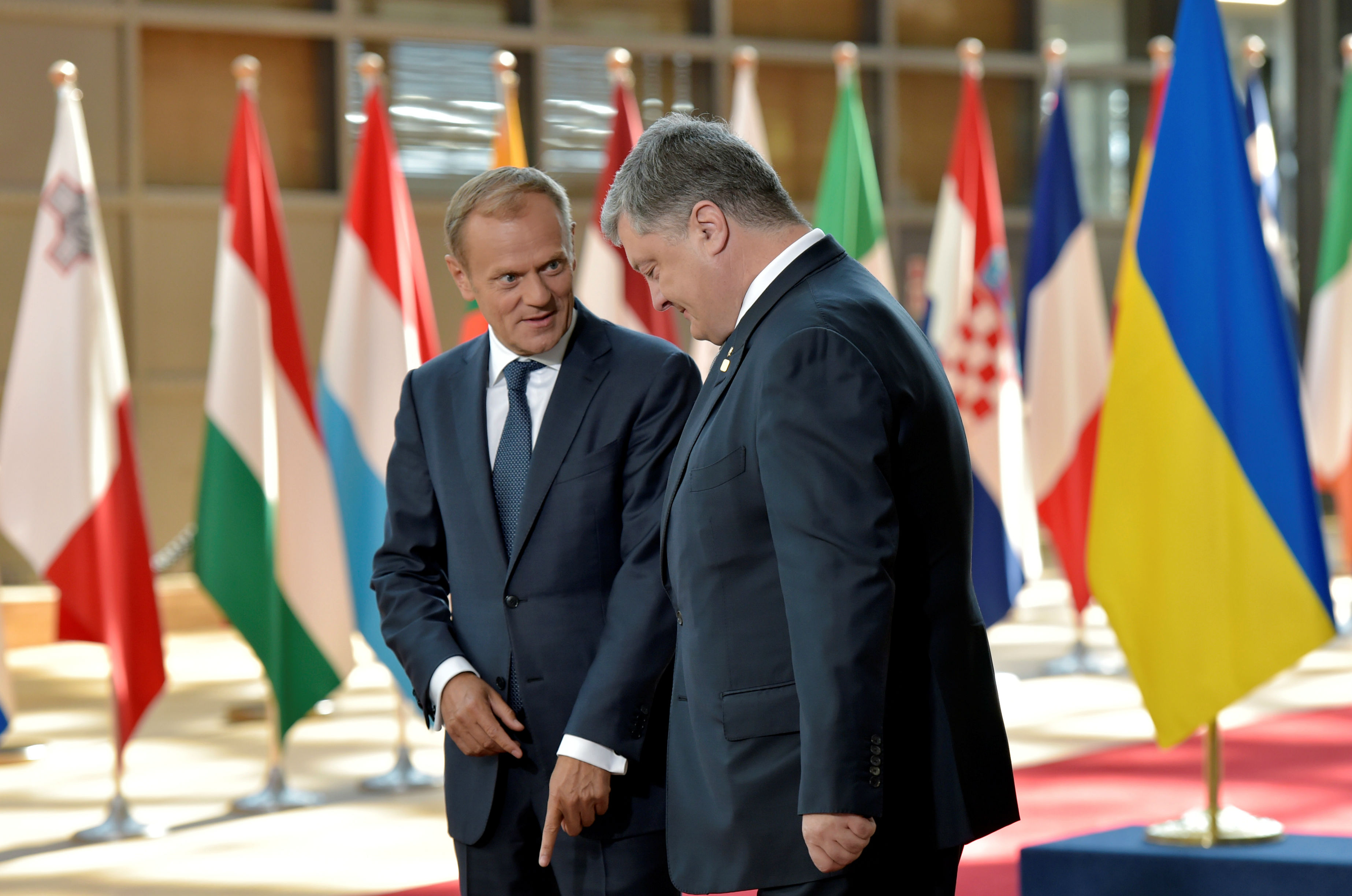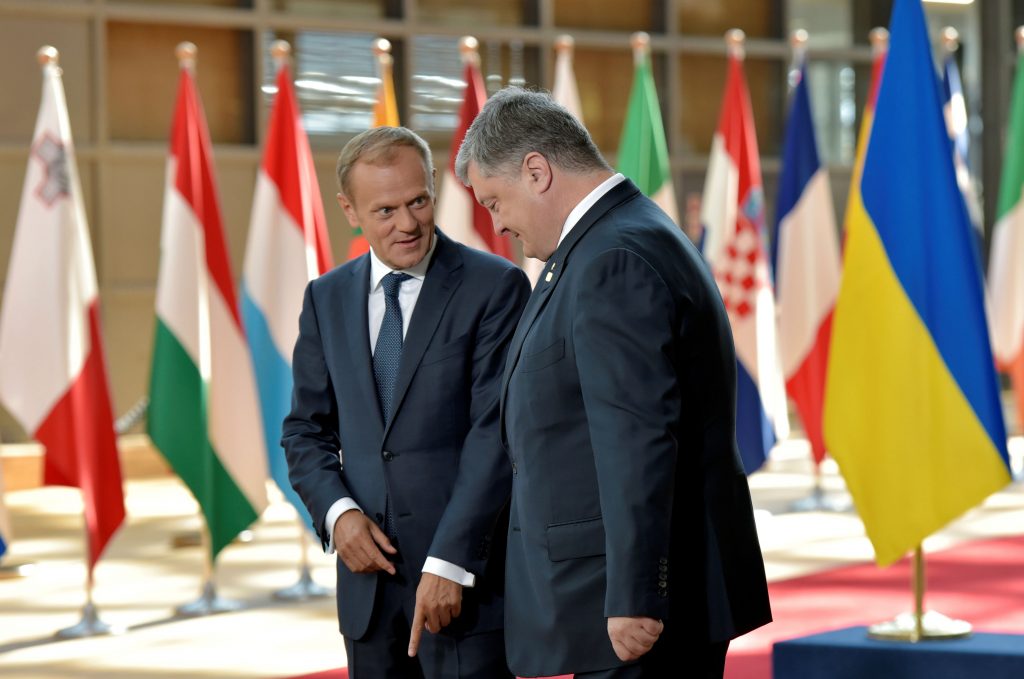 On July 9, Ukraine President Petro Poroshenko and European Council President Donald Tusk plan to meet at the EU-Ukraine Summit in Brussels to discuss a range of issues. Anticorruption reform will rightfully be at the top of the list, but there’s another issue that the Europeans should raise forcefully. One that escapes the headlines.
On July 9, Ukraine President Petro Poroshenko and European Council President Donald Tusk plan to meet at the EU-Ukraine Summit in Brussels to discuss a range of issues. Anticorruption reform will rightfully be at the top of the list, but there’s another issue that the Europeans should raise forcefully. One that escapes the headlines.
That issue is Ukraine’s more than 1.7 million internally displaced persons.
Ukraine is facing its biggest forced internal migration since the Chernobyl nuclear disaster in 1986. Roughly 3 percent of the population—the largest number of IDPs in Europe—has been integrated without major drama or refugee outflows.
Ukraine should get major kudos for this achievement, and as international humanitarian organizations press other countries to integrate their internally displaced persons rather than sideline them, this nation of 44 million could become a global leader for how to do the job right.
Ukraine’s IDPs are remarkable and resilient. Many stories have been told already. Viktoria from Donetsk region moved to Lutsk where she renovated a local fish plant that employs eleven people. Valeriy, a Crimean Tatar, now runs his own greenhouse in the Volyn region and was elected a local deputy. He’s cleaning the local lake and acquainting members of the community with Crimean traditions.
These stories make us feel good and check out, but there’s still major issues that Ukraine needs to resolve. IDPs complain about housing, registration requirements, employment, and high utilities.
Housing is the problem that just won’t go away. In 2014, when the first wave of migrants began pouring in, local authorities and society solved the problem by providing temporary accommodation in hospitals, summer camps, and sanatoriums. However, the belief that the need would be short term was dramatically wrong, and some of those living in temporary housing have been doing so for months or even years.
Building settlements and transit towns to house the IDPs has been one approach. Georgia and Azerbaijan tried this in the 1990s, but these expensive and unpopular settlements tend to isolate IDPs. Isolation complicates integration, employment, and residents’ ability to access medical help and education.
While a majority of IDPs tell the International Organization for Migration that they feel safer in the territory that Ukraine fully controls, 78 percent plan to stay in rebel-held areas for the next three months because of housing. In the rebel-held areas, they don’t have to pay rent.
Ukraine’s IDPs are barely making ends meet. As of March, over half barely have enough money to buy food on a day-to-day basis. The current average monthly income per IDP is UAH 2,239 ($85), a little less than what they made in December 2017 which was UAH 2,446 ($93). These figures are below the current subsistence levels of UAH 3,215 ($122) per month.
Unemployment also remains a sticking point for IDPs, although the picture is getting better. At the beginning of 2018, 60 percent of migrants were employed, compared with 30 percent in 2015.
Part of the explanation for low employment rests with the nature of Ukraine’s IDPs. They’re different from the average IDP. According to the Office of the United Nations High Commissioner for Refugees, the proportion of men and women among IDPs in the world is approximately equal. But in Ukraine, there are far more women. Moreover, 24 percent of IDPs are able-bodied adults, 59 percent are retired, 13 percent are children, and 4 percent are persons with disabilities. Due to resettlement, over half of the women who worked previously are now unemployed. They also belong to the most vulnerable part of the labor force and often face unfavorable working conditions and lower wages.
In 2014, the government allocated state aid for rental and living costs, and that is still in force. However, in the last two years, the number of IDPs who register and apply for social assistance has fallen, and fewer than 15 percent of registered IDPs receive assistance. People have settled into their new residences and not renewed their status; others struggle to prove their IDP status, particularly where there is little financial incentive to do so. The benefit for an able-bodied person is 884 UAH ($33); for retired people and children, it’s 442 UAH ($17), and not more than 2,400 UAH ($91) for a family. And IDP status should be renewed every six months. Without this, no one from the occupied territories can hope to receive social help.
Relief organizations say the cumbersome process to receive assistance is part of the problem. “Receiving or renewing identification documents, social benefits, and pensions are the main questions we are asked on the hotline,” explains Olga Gvozdyova, an advocacy coordinator of the NGO Donbas SOS. “The system of verification and after-service in banking and the social services makes many IDPs feel less welcome.”
Acknowledging that IDPs are not a temporary problem but an irreversible, still-changing issue affecting all of Ukrainian society is the first place to start.
The government of Ukraine should step up its efforts to provide housing, relax the six month registration requirement for IDPs, and increase social assistance.
Ukrainians have responded remarkably to people in need. It’s time for the government to do the same.
Anna Kyslytska is an analyst at Internews Ukraine and at UkraineWorld, an information and networking initiative.
Image: European Council President Donald Tusk (L) meets with Ukrainian President Petro Poroshenko in Brussels, Belgium June 22, 2017. REUTERS/Eric Vidal
